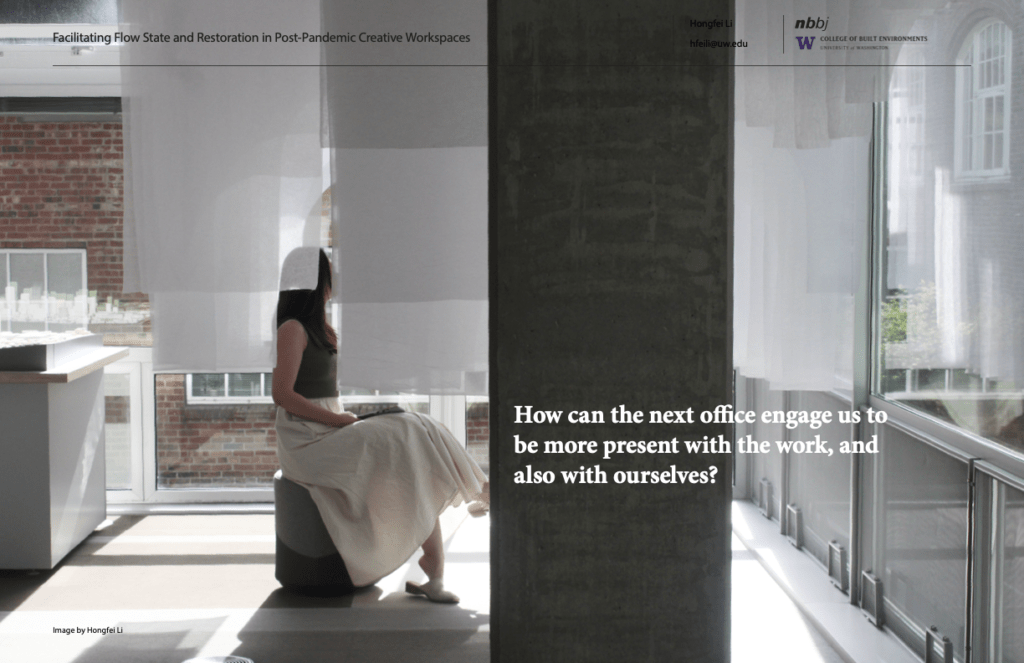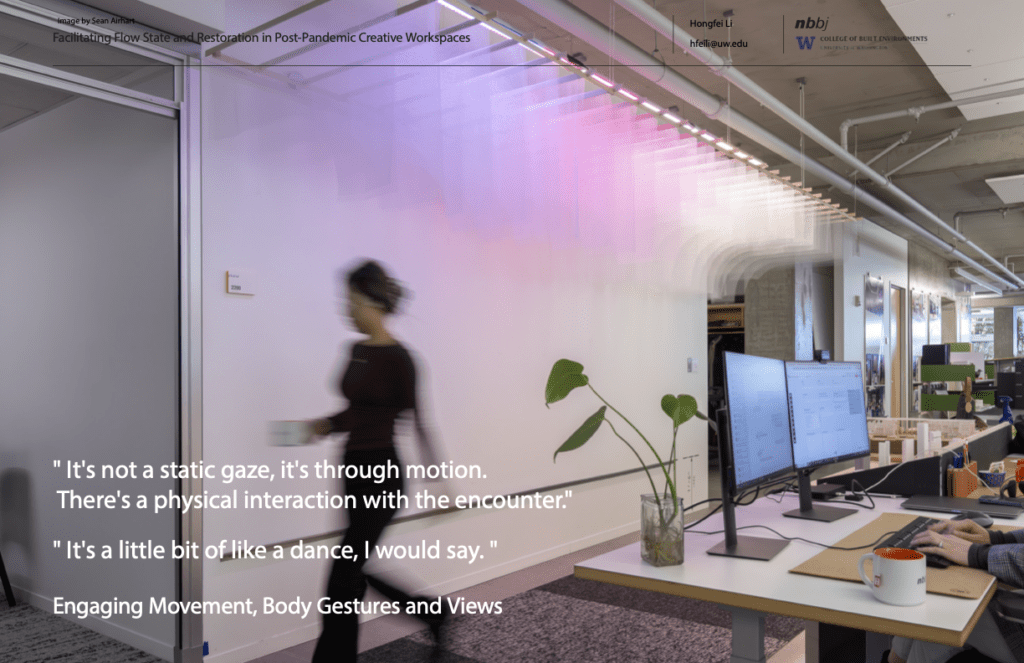August 1, 2024
Facilitating Flow State and Restoration in Post-Pandemic Creative Workspaces
ARC Fellow: Hongfei Li
Degree Program: PhD in the Built Environment
Faculty Advisors: Lynne Manzo (Landscape Architecture), Tivon Rice (DXARTS)
Firm: NBBJ
Firm Advisors: Ryan Mullenix
Project dates: Autumn 2023 – Spring 2024
Read the Project Report
View the Presentation
View the Presentation Slides
More about the project:
As we continue to move through the pandemic, the transition to hybrid work models and greater reliance on digital tools necessitates a redefinition of traditional office spaces. In the creative industry, the organic and fluid interactions among colleagues remain crucial for dynamic, team-based creativity. An increasing number of firms require a return to in-person work. This transition highlights the need for workspaces that blend the opportunity for deep-focused work and restorative breaks necessary for productive creativity and well-being. When office design does not meet these needs, employees experience more fatigue and burnout. As a common ground, how can the workplace support well-being and facilitate individual and collective human flourishing? A key element for human flourishing and well-being in the work context is achieving a flow state- a state of deep immersion and heightened performance and creativity (Csikszentmihalyi, 1990).
This study proposes a new framework based on the dynamic stages of flow (Benson, 2003), focusing on the cycles that include focus, struggle, release, flow, and recovery. This study explores the interplay of these stages with environmental factors, seeking to understand how transitions between stages of flow can be facilitated. This research aims to understand (1) the experience of flow, its dynamic stages, and how environmental factors impact them in the creative workplace; (2) what restorative transition helps employees achieve and sustain the flow state. Regarding this restorative aspect, the study considers mindfulness-based interventions (Menardo et al., 2022) and biophilic design as critical elements in promoting workplace well-being. This research hypothesizes that design strategies informed by mindfulness and biophilia can enable the critical shift necessary for restorative stages, thereby enhancing the flow state. The goal is to provide actionable design insights for facilitating mental shifts and restorations in workplace environments.
This applied research includes a pilot study conducted at a Pacific Northwest design firm, NBBJ. The study has three phases. The first phase establishes the framework for understanding flow, its dynamic stages, and the environmental factors that support it. The second phase collects data through observations, interviews, and surveys to understand how employees experience flow, creativity, struggle, and fatigue and how office space impacts them. The last phase consists of constructing and testing a physical prototype in the office setting, informed by mindfulness-based intervention and biophilic design. This prototype helps determine what environmental factors can help restore and facilitate the shift to flow. Lastly, this research aims to pioneer new paradigms in workspace design, transforming post-pandemic work environments into catalysts for well-being and creative excellence.
Reference:
Csikszentmihalyi, M. (1990). Flow: The psychology of optimal experience
Benson, H., & Proctor, W. (2003). The break-out principle: How to activate the natural trigger that maximizes creativity, athletic performance, productivity, and personal well-being. Scribner.
Menardo, E. et al (2022). Nature and Mindfulness to Cope with Work-Related Stress: A Narrative Review. International Journal of Environmental Research and Public Health, 19(10), 5948.

Flow is not just about being in the zone. It has dynamic stages and how we facilitate the transition between stages is critical. HONGFEI LI

Theoretical background. HONGFEI LI

The lounge area piece: Projective design. HONGFEI LI

Corridor Piece: Projective design. HONGFEI LI
